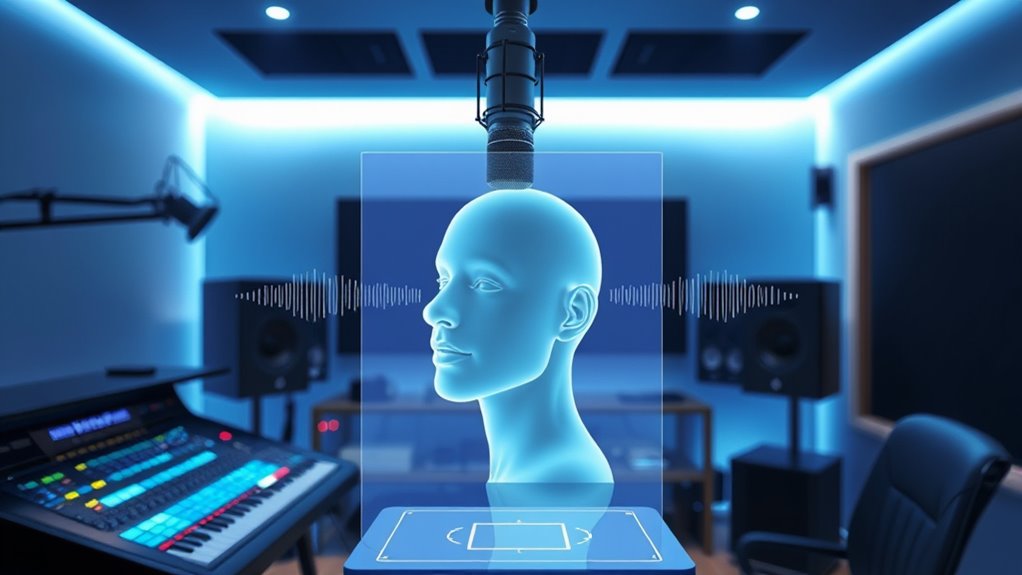Voice cloning and synthetic voices create powerful opportunities to improve accessibility, helping those with speech impairments communicate naturally and making content more engaging. These technologies can revive old recordings, personalize entertainment, and support language learning. However, they also pose ethical risks like impersonation, misinformation, and privacy violations. Staying aware of these issues is vital, and by continuing, you’ll uncover ways to balance innovation with responsible use, ensuring these tools benefit society positively.
Key Takeaways
- Synthetic voices enhance accessibility for speech-impaired individuals and language learners through natural, personalized communication tools.
- Advances enable revitalization of historical recordings, promoting preservation and educational opportunities.
- Ethical concerns include privacy risks, potential misuse for scams, impersonation, and misinformation.
- Responsible development involves safeguards like watermarks, transparency, and regulation to prevent malicious use.
- Balancing creative potential with ethical considerations remains crucial for societal benefits and mitigating risks.

Have you ever wondered how technology can mimic a person’s voice so precisely that it sounds just like them? It’s fascinating how advanced voice cloning and synthetic voices have become, allowing machines to produce speech indistinguishable from real human voices. These innovations open up incredible possibilities, especially in creative applications where storytellers, game developers, and content creators can craft compelling audio experiences. However, with such power comes serious responsibility, particularly around privacy concerns. When your voice can be replicated so convincingly, it becomes easier for malicious actors to impersonate you, potentially leading to scams, identity theft, or misinformation. This raises the question: how do we protect ourselves in an era where our voice can be duplicated with just a few samples? Developers and policymakers are working on safeguards, like authentication protocols and watermarks embedded in synthetic voices, but the risks remain real. It’s vital to stay aware and cautious about where and how your voice data is used. Additionally, understanding the distinctions between BTU and CADR ratings can help consumers make informed choices about the audio and air quality devices they use, ensuring safety and quality in their environments.
On the other hand, these technological breakthroughs have enormous creative applications. For example, voice cloning can revitalize old audio recordings, giving new life to historical figures or loved ones who have passed away. It also enables personalized experiences in entertainment, where characters can speak in unique, realistic voices tailored to individual preferences. Voice synthesis can assist in language learning, offering clear, natural pronunciation for students or helping people with speech impairments regain their ability to communicate more naturally. These applications highlight how synthetic voices can foster inclusion and creativity, making content more accessible and engaging. Yet, even as you celebrate these benefits, it’s essential to recognize the ethical dilemmas involved. The line between legitimate use and misuse can blur quickly, especially when cloned voices are used to manipulate or deceive. For instance, fake voice recordings can be used to spread false information or to impersonate someone without their consent, causing psychological or reputational harm.
The key to maneuvering this landscape is a balanced approach. While embracing the innovative potential of voice cloning, you must also demand transparency and accountability from creators and users of this technology. Laws and regulations are beginning to catch up, but staying informed and cautious is your best defense. Ultimately, synthetic voices are a powerful tool — one that holds incredible promise for creative expression and accessibility, but also requires vigilance to prevent abuse. As you explore these new frontiers, remember that respecting privacy and adhering to ethical standards isn’t just responsible; it’s essential for ensuring that these advancements benefit society without infringing on individual rights.
Frequently Asked Questions
How Secure Are Voice Cloning Technologies Against Malicious Use?
Voice cloning technologies can be quite vulnerable to malicious use, posing significant privacy concerns and authentication risks. You might find that hackers or bad actors could impersonate someone convincingly, leading to identity theft or fraud. While advancements improve security, it’s essential to stay cautious. Implementing multi-factor authentication and monitoring for suspicious activity helps protect against these threats, but the risk remains if safeguards aren’t properly managed.
Can Synthetic Voices Accurately Convey Emotions and Tone?
Sure, synthetic voices can mimic emotions and tone accuracy—sometimes better than humans! Ironically, they often struggle with emotional authenticity, sounding a bit robotic or overly rehearsed. While advances help them convey basic feelings, capturing the subtle nuances of genuine emotion remains challenging. So, if you’re craving heartfelt sincerity, you might still prefer real voices, but for quick tone adjustments, these synthetic options are surprisingly effective.
What Are the Costs Associated With Developing Custom Synthetic Voices?
The costs for developing custom synthetic voices vary based on complexity and quality, with a detailed cost analysis needed. Market pricing can range from a few thousand dollars for basic voices to tens of thousands for highly realistic, personalized options. You should consider factors like data collection, voice modeling, and licensing fees. Budgeting accordingly guarantees you get the best quality within your financial limits, making a thorough cost assessment essential.
How Do Regulations Differ Across Countries Regarding Voice Cloning?
Regulations on voice cloning vary widely across countries due to differing legal frameworks and cultural differences. In some nations, strict laws protect individuals’ voice rights, requiring consent for cloning, while others have minimal regulation. You need to stay informed about local laws, as cultural attitudes influence how voice cloning is governed. Always consider both legal and cultural contexts to make certain of ethical use and compliance when working with synthetic voices abroad.
Are There Limitations to Replicating Voices With Complex Accents or Speech Patterns?
Imagine trying to clone a voice with a thick Scottish accent and unpredictable speech patterns—it’s tough. You’ll face accent challenges and speech variability that make accurate replication difficult. These complexities can lead to unnatural or misunderstood outputs, especially for voices with unique intonations or colloquialisms. So, yes, there are limitations, and capturing the authentic nuance of complex accents remains a significant hurdle in voice cloning technology.
Conclusion
As you consider the future of voice cloning and synthetic voices, ask yourself: are we truly prepared to navigate the ethical challenges they bring? While these technologies can increase accessibility and open new creative avenues, they also pose risks of misuse and deception. It’s up to us to balance innovation with responsibility. Will we harness their potential for good, or let ethical concerns undermine their promise? The choices we make now will shape the voice of tomorrow.










